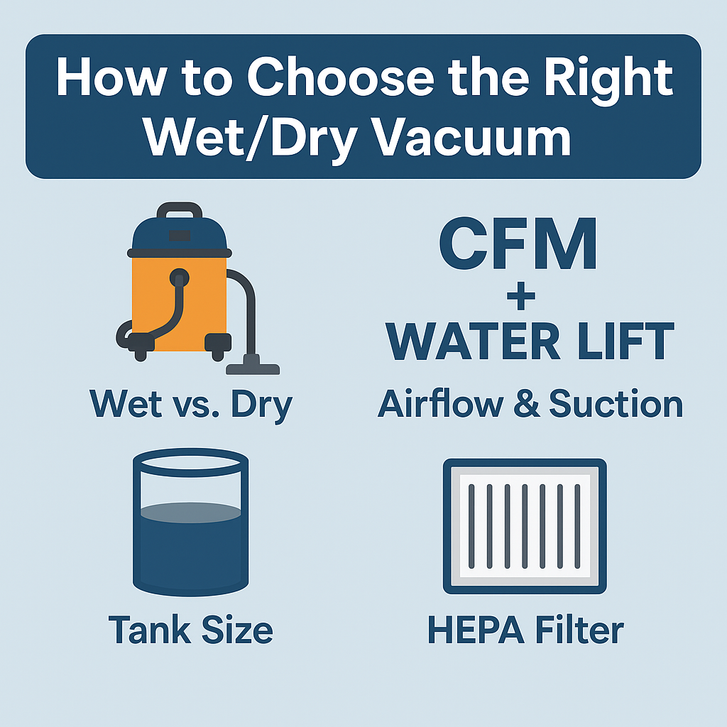How to Choose the Right Wet/Dry Vacuum for Your Needs
Wet/dry vacuums are versatile tools essential for both residential and commercial cleaning tasks. Whether you're tackling a flooded basement, managing construction debris, or performing routine maintenance, selecting the appropriate wet/dry vacuum is crucial. Here's a comprehensive guide to help you make an informed decision.
Understanding Wet vs. Dry Capabilities
-
Dry Vacuuming: Ideal for collecting dust, dirt, and small debris from floors, carpets, and workspaces.
-
Wet Vacuuming: Designed to handle liquid spills, flooded areas, and damp surfaces.
Most wet/dry vacuums can seamlessly transition between these modes, but always check the manufacturer's specifications to ensure suitability for your specific tasks.
Key Performance Metrics: Water Lift and CFM
Water Lift (Sealed Suction)
-
Measured in inches, water lift indicates the vacuum's ability to lift water vertically.
-
Higher water lift values are essential for extracting liquids from deep or low-lying areas.
CFM (Cubic Feet per Minute)
-
Represents the volume of air the vacuum moves per minute.
-
Higher CFM values ensure efficient debris and liquid transport through the vacuum system.
An optimal balance between water lift and CFM ensures effective cleaning performance.
Selecting the Appropriate Tank Capacity
-
Small Capacity (2–6 gallons): Suitable for minor spills, vehicle interiors, and tight spaces.
-
Medium Capacity (7–14 gallons): Ideal for general household cleaning and moderate commercial tasks.
-
Large Capacity (15+ gallons): Designed for extensive cleanup operations, such as flood recovery and large-scale construction sites.
Types of Wet/Dry Vacuums
-
Portable Units: Lightweight and easy to maneuver, perfect for quick cleanups and mobile tasks.
-
Drum Vacuums: Feature large-capacity tanks, suitable for industrial applications and prolonged use.
-
Pump-Out Vacuums: Equipped with built-in pumps to discharge collected liquids continuously, eliminating the need for manual emptying.
HEPA Filtration: Is It Necessary?
High-Efficiency Particulate Air (HEPA) filters trap 99.97% of particles as small as 0.3 microns. Consider HEPA filtration if:
-
You're working in environments with hazardous dust or allergens.
-
Compliance with health and safety regulations is required.
-
Maintaining indoor air quality is a priority.
Pump-Out Feature: Enhancing Efficiency
For tasks involving significant liquid collection, vacuums with pump-out capabilities offer continuous operation without frequent interruptions to empty the tank. These models are particularly beneficial for flood recovery and large-scale water removal projects.
✅ Should You Add a Front Mount Squeegee?
If you're regularly cleaning large areas with wet spills or water recovery, a front mount squeegee is a powerful upgrade worth considering. Instead of relying on a standard wand or hose, a front mount squeegee lets you push and collect water in a wide path, just like an auto scrubber — but without the solution tank.
⭐ Benefits of a Front Mount Squeegee:
-
Speeds up water pickup on tile, concrete, and sealed floors
-
Ideal for gyms, warehouses, flood zones, and restrooms
-
Reduces back strain by eliminating constant wand use
-
Creates cleaner, drier floors faster than traditional hose-only recovery
Many commercial wet/dry vacs—especially drum-style or high-capacity units—can be equipped with a compatible squeegee tool mounted directly on the front frame.
If you're doing flood recovery, garage bay cleaning, or cleaning in wide-open spaces, this add-on can dramatically boost productivity.
➡️ Shop Wet/Dry Vacs with Squeegee Attachments
Need Assistance?
Choosing the right wet/dry vacuum can be challenging. For personalized recommendations:
-
Email: sales@monsterjanitorial.com
-
Call: 956-772-4842
Our team at Monster Janitorial is dedicated to providing expert advice, fast shipping, and factory-direct pricing.

